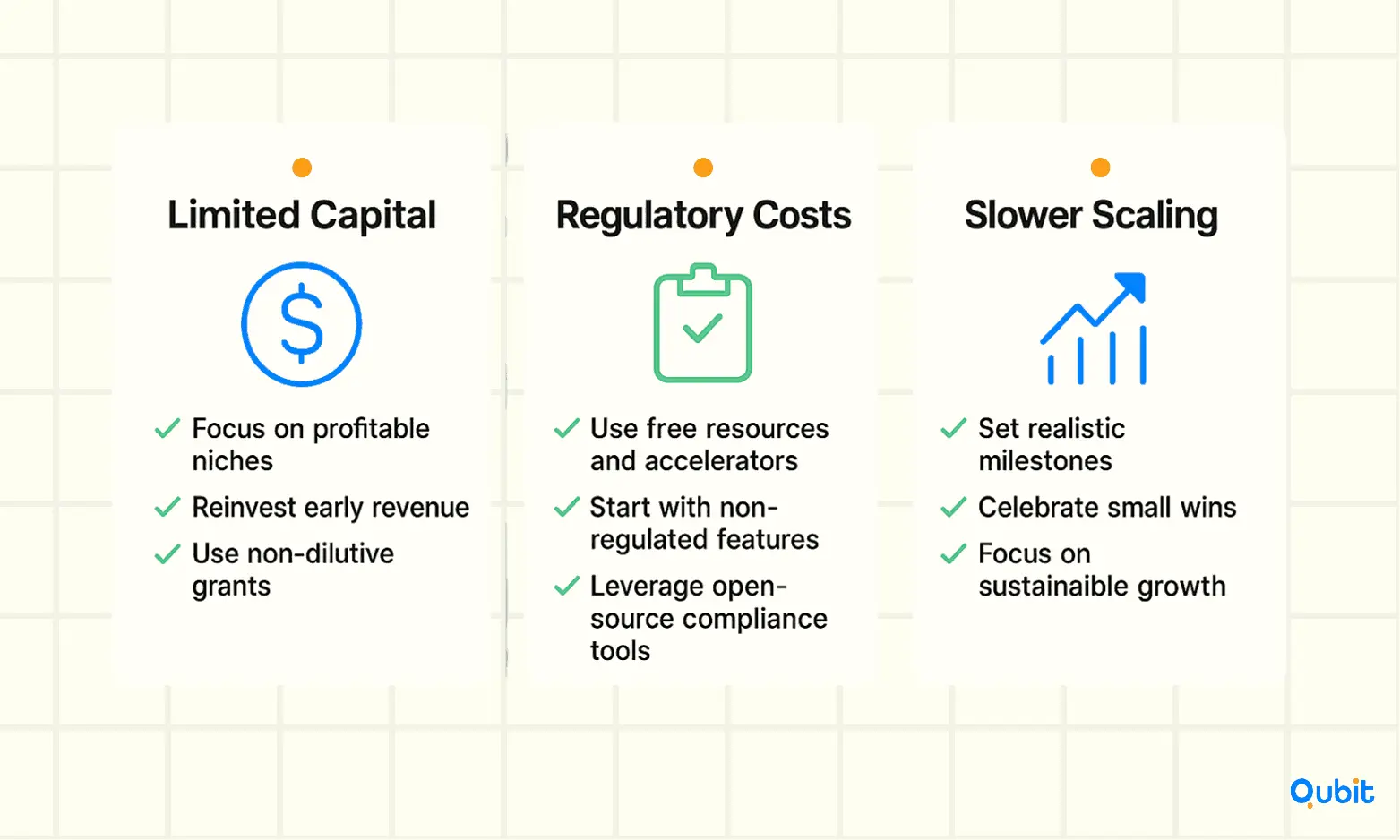While venture capital funding for digital health has dropped nearly 50% since its 2021 peak, more founders are realizing that bootstrapping, building a company with minimal or no outside investment, can be a powerful, sustainable path to market. For many healthcare innovators, bootstrapping isn’t just a fallback; it’s a strategic choice that prioritizes real business models, customer validation, and long-term control.
This article explores what it means to bootstrap a healthtech venture, why this approach is gaining traction, and how founders can navigate the unique hurdles of healthcare innovation with limited resources. You’ll find actionable strategies, real-world examples, and insights to help you thrive, no matter how lean your starting point.
This guide is for healthtech founders navigating early-stage, self-funded growth.
What Is Bootstrapping in HealthTech? A Quick Primer
Bootstrapping means building your startup using personal savings, early revenues, and careful resource management, rather than relying on external investors. It’s about making every dollar count, prioritizing essentials, and growing at a pace you control.
Common bootstrapping tactics:
- Self-funding (personal savings, loans from friends/family)
- Reinvesting early customer revenue
- Lean operations and cost discipline
- Strategic partnerships and bartering
- Leveraging free or low-cost tools and platforms
Why Bootstrapping Makes Sense in Health Tech
1. The Changing Funding Landscape
Venture capital for digital health has dropped by about 49% in recent years, and the bar for raising external funding is higher than ever. Investors want proof: real traction, solid unit economics, and a credible path to profitability.
In this environment, bootstrapping a HealthTech startup gives founders room to build on their own terms. Instead of chasing rounds, you can:
- Retain full control and equity
- Focus on sustainable, revenue-driven growth
- Build real businesses, not just pitch decks
- Stay agile and avoid growth-at-all-costs pressure
At the same time, global venture funding has become more selective. There is still plenty of money in the system, but it increasingly flows to later-stage or “de-risked” bets. That makes lean, bootstrapped execution an advantage, not a weakness—, or early HealthTech founders.
2. The Power of AI and Lean Tech
A large share of new startups now rely on AI-driven tools to boost productivity and cut operating costs. That shift lets HealthTech founders:
- Build MVPs quickly
- Run real-world experiments earlier
- Iterate based on data instead of opinions
In other words, the tech stack finally supports a bootstrapped-first approach.
3. Customers as Your Best Investors
In healthcare, your early customers, clinics, hospitals, insurers, employers, or even patients, can be your most valuable investors.
When a clinic pays for your product, you don’t just get revenue. You get:
- Capital that doesn’t dilute your equity
- Validation that the problem is real and painful
- Direct feedback from the people using your solution
That’s far more useful than a “nice pitch” and no deployments.nders
Bootstrapping Playbook Overview
1. Start With a Real Problem and a Focused MVP
Start with a minimum viable product (MVP) for a specific user group. For example, launch your telemedicine platform with basic video consults, then add features.
Tips:
- Interview clinicians, patients, and administrators to understand their workflow gaps.
- Focus on a single, high-impact use case.
- Build only what’s necessary to test your core hypothesis.
2. Prioritize Revenue Early
Unlike many tech sectors, healthcare organizations will pay for solutions that address urgent needs—even if they’re early-stage. Launch your MVP, secure early adopters, and reinvest profits to fund development.
Example:
Frontier Psychiatry bootstrapped to 75 staff and 5,000 patients/month by focusing on revenue from day one—proving their model with real customers, not just investors.
3. Embrace Lean Operations
Bootstrapped startups must be ruthless about costs. Use free or affordable tools, outsource non-core tasks, and keep your team small until you have the revenue to expand.
Cost-saving strategies:
- Use open-source software for development.
- Leverage no-code/low-code platforms for rapid prototyping.
- Rent or share office/lab space only when necessary.
4. Resource Allocation and Financial Discipline
Track your burn rate—the rate at which you use cash each month.
Focus spending on activities that drive revenue or product validation. Avoid unnecessary overhead.
- Negotiate with vendors: Seek discounts or deferred payment terms.
- Barter services: Trade expertise with other startups or local providers.
- Delay hiring: Outsource or automate before making full-time hires.
5. Navigate Regulatory and Compliance Challenges on a Budget
Healthcare is highly regulated, but bootstrapped startups can still make progress:
- Start with non-regulated features: Launch pilot programs or non-clinical modules first.
- Leverage accelerators and university partnerships: Many offer free compliance workshops or access to regulatory experts.
- Use open-source compliance tools: For HIPAA, GDPR, or other standards.
6. Build Strategic Partnerships
Partnerships can provide resources, credibility, and distribution without diluting equity. For example, collaborating with a university might give you access to lab space, research expertise, or pilot users in exchange for data or co-authorship.
Examples:
- Partnering with a hospital for real-world pilots.
- Collaborating with a pharma company for clinical validation.
- Working with local health departments to access underserved populations.
7. Innovate and Adapt Quickly
Bootstrapping encourages a culture of resourcefulness and rapid iteration. Use customer feedback to refine your product, and don’t be afraid to pivot if the market signals a better opportunity.
9. Customer-Centric Product Development
Bootstrapped startups often have a closer relationship with their first customers. Use this to your advantage: co-develop features, run pilots, and turn early adopters into champions and references.
Harnessing public enthusiasm can turn your community into backers, Crowdfunding Options for HealthTech Startups lays out the platforms and pitch tactics that actually move the needle.
10. Build Advisory Networks and Seek Mentorship
Establishing advisory networks and seeking mentorship provides bootstrapped healthtech founders with access to seasoned expertise and strategic guidance. Advisors can help navigate regulatory complexities, refine product-market fit, and identify partnership opportunities that may not be obvious to first-time founders. Mentors offer practical advice drawn from real-world experience, helping founders avoid common pitfalls and accelerate learning. These relationships often open doors to new networks, pilot programs, and credibility within the healthcare ecosystem.
Challenges of Bootstrapping Your HealthTech Venture and How to Overcome Them
Bootstrapping healthtech companies presents unique challenges, especially when it comes to securing resources for growth.

1. Limited Capital for Growth
Why it’s a challenge:
Investors often prefer later-stage companies with proven business models, leaving early ventures with limited resources to scale operations or invest in technology and infrastructure. The capital-intensive nature of healthcare—covering regulatory approvals, product development, and market entry, means that lack of funds can slow growth, limit hiring, and delay key milestones. Additionally, longer gaps between funding rounds and unpredictable market shifts can further strain financial runway.
Solution:
Focus on profitable niches where you can demonstrate clear value and secure early revenue. Reinvest earnings to fund growth and explore non-dilutive funding options like grants or innovation challenges. Consider staged launches, prove your model in one segment or geography before expanding to avoid overextending limited resources.
2. Regulatory and Compliance Costs
Why it’s a challenge:
Healthtech is one of the most regulated sectors, with complex requirements for data privacy, patient safety, and clinical efficacy. Navigating these pathways is costly and time-consuming, often requiring specialized legal, clinical, and technical expertise. Regulatory delays or unexpected compliance hurdles can burn through limited capital, disrupt product timelines, and erode investor confidence. For bootstrapped startups, these costs can be particularly daunting, as even a small misstep may require expensive remediation or halt progress altogether.
Solution:
Leverage free resources, accelerators, and partnerships for compliance expertise. Many programs offer workshops, mentorship, or access to regulatory advisors at little or no cost. Start with non-regulated features or pilot programs to build data and credibility before tackling full-scale regulatory approvals. Use open-source compliance tools and seek guidance from industry networks to minimize costs while ensuring you meet essential standards.
3. Slower Pace of Scaling
Why it’s a challenge:
Bootstrapped startups must grow within their means, often resulting in a slower pace of scaling compared to VC-backed peers. Limited capital constrains hiring, product development, and marketing, making it harder to capture market share quickly or respond to competitive threats. In healthcare, where achieving scale can be crucial for clinical validation, payer adoption, and network effects, this slower growth can limit visibility and delay access to larger funding rounds or strategic partnerships.
Solution:
Set realistic milestones and focus on sustainable, stepwise growth. Celebrate small wins to maintain team morale, and use customer feedback to guide product development and prioritization. Remember, in healthtech, sustainable growth and operational resilience are often more valuable than rapid, unsustainable expansion.
The Benefits of Bootstrapping in HealthTech
- Culture of innovation: Bootstrapping healthtech startups fosters creative problem-solving and a bias for action.
- Full ownership and control: No pressure from outside investors to prioritize short-term growth over long-term impact.
- Stronger business fundamentals: Revenue-first models force you to validate your solution and unit economics early.
- Agility and resilience: Lean teams adapt faster to market feedback and regulatory changes.
- Easier early exits: Many healthtech acquisitions happen below $50M, making capital-efficient growth attractive for founders seeking early liquidity.
Validating your clinical model with real commitments boosts credibility, how to secure funding for healthcare startups: a step-by-step guide breaks down every milestone from pitch deck to term sheet so you can streamline your fundraising journey.
Bootstrapping vs. Fundraising: Which Is Right for You?
There’s no one-size-fits-all answer. Bootstrapping works best for founders who value control, are solving clear problems, and can reach early revenue with limited capital. Fundraising may be necessary for capital-intensive products, large-scale clinical trials, or rapid market expansion.
Consider bootstrapping if:
- Your MVP can be built and launched with <$500K.
- You have access to early customers or pilot partners.
- You’re comfortable with slower, sustainable growth.
Consider external funding if:
- Your product requires significant R&D or regulatory investment.
- You’re targeting a massive, fast-moving market.
- You need to scale quickly to beat competitors.
Seed rounds typically range from $500,000 to $5 million for early-stage companies. Comparing this to bootstrapping paths highlights the financial discipline required but also the accessibility for founders seeking control.
Moving past proof-of-concept requires a clear roadmap, Series A & B Funding Strategies for HealthTech walks through the negotiation levers and growth metrics that give investors confidence to write bigger checks.
Future Trends: Bootstrapping in HealthTech
The future of bootstrapping healthtech ventures will be shaped by new tools and evolving market dynamics.
- No-code and AI tools– will make it even easier to build and iterate on healthtech products with minimal resources.
- Smaller, profitable exits– will become more common, as acquirers seek nimble, capital-efficient startups.
- Hybrid models– bootstrapping early, then raising growth capital, will gain traction as founders seek to maximize both control and scale.
Technology will keep driving efficiency. By 2033, global AI market value is expected to reach nearly $3.5 trillion, up from $391 billion today. This rapid expansion positions healthtech founders to launch and iterate products faster than ever.
Practical Tips for Bootstrapped HealthTech Founders
- Start small and iterate fast.
- Keep your burn rate low, track every expense.
- Listen to your customers, they’re your best investors.
- Leverage partnerships for resources and credibility.
- Embrace non-dilutive funding when available.
- Stay focused on your mission and core value proposition.
Conclusion
Bootstrapping a healthtech venture is not only viable, it’s often the smartest path for founders who want to build sustainable, impactful businesses. By focusing on real customer needs, disciplined spending, and creative partnerships, you can bring innovative healthcare solutions to market without giving up control or equity. The journey requires grit, resourcefulness, and a relentless focus on value, but the rewards are lasting.
If you’re looking to fuel progress without dilution, at Qubit we understand grants, milestone-based vendor terms, and revenue-backed plans. Build your runway with our funding assistance for healthcare startups and schedule a discovery session.
Key Takeaways
- Bootstrapping in healthtech means building your business without relying on external funding, allowing you to retain full ownership and control.
- This approach encourages creativity, innovation, and resourcefulness, as founders must solve problems and grow with limited resources.
- Cost efficiency, lean operations, and prioritizing early revenue are essential to sustaining and scaling a bootstrapped healthtech venture.
- Non-dilutive funding sources like government grants can supplement bootstrapping and help overcome regulatory or R&D hurdles.
- Bootstrapping fosters a customer-centric mindset, focusing on solving real problems and validating business models before aggressive scaling.
Frequently asked Questions
What are the best bootstrapping strategies for HealthTech startups in 2025?
Leverage AI and no-code tools to build MVPs quickly, prioritize early customer revenue, and form strategic partnerships for resources. Focus on lean operations and non-dilutive funding.






